...then, we would love to know the source of the hornbeam. Is it possible to share?Hello Dima. I did not take a red hornbeam from Sergey (Bibigon). He didn't have. I bought a bar from the guys who make knife handles. The bar is not large, but enough for gun mounts even on a 12th scale....
-

Win a Free Custom Engraved Brass Coin!!!
As a way to introduce our brass coins to the community, we will raffle off a free coin during the month of August. Follow link ABOVE for instructions for entering.
-

PRE-ORDER SHIPS IN SCALE TODAY!
The beloved Ships in Scale Magazine is back and charting a new course for 2026!
Discover new skills, new techniques, and new inspirations in every issue.
NOTE THAT OUR FIRST ISSUE WILL BE JAN/FEB 2026
You are using an out of date browser. It may not display this or other websites correctly.
You should upgrade or use an alternative browser.
You should upgrade or use an alternative browser.
118 Gun French three-decker - Le Commerce de Marseille / L'Ocean - scale 1:72
Dima, I shared. Guys who make knives. Handles for knives are also made from hornbeam. We have many private workshops in Russia that are engaged in the manufacture of knives. Here I bought a bar of red hornbeam from them....then, we would love to know the source of the hornbeam. Is it possible to share?
- Joined
- Jan 21, 2022
- Messages
- 853
- Points
- 403

I could buy hornbeam and stain it. I could also buy some plumb. Is it a good option?Wojtas, good afternoon. If you need red looms, why not use red hornbeam?
I bought padouk because it had the closest color that i wanted to get. I didn't know it would be that hard to process.
Only problem is with gun carragies. From what I've managed to learn there're two ways of making them. Milling or gluing layers of wood. I can't cut it longwise to get such layers, milling is too exhausting. I also think it would be waste of good material because you can't see the gun carragies on lower decks, but upper deck is option to consider
I still want to use this african woods for inner hull. Cuting 2 or 3 mm strips is no problem and those dots are so beautiful.
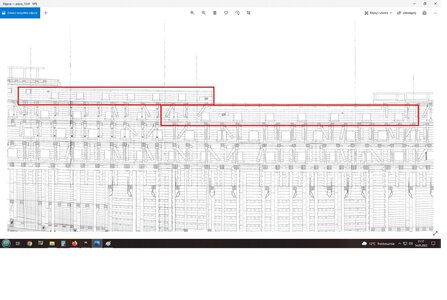
Last edited:
- Joined
- Jan 21, 2022
- Messages
- 853
- Points
- 403

Little update
I've prapared some concepts about colors of planks. It all fell apart because of stiffnes of exotics. First I'll show them and later ask about your opinion to some solutions
Matching with plans(loosly)
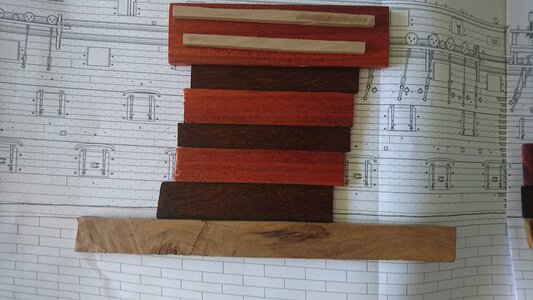
From top
1.Pear stained to black+padouk with linseed oil + pear with linseed oil
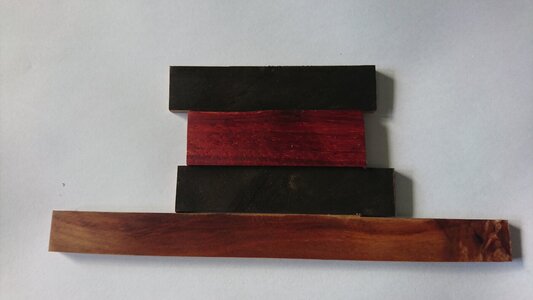
2.Ebony with linseed oil +padouk with linseed oil + pear with linseed oil
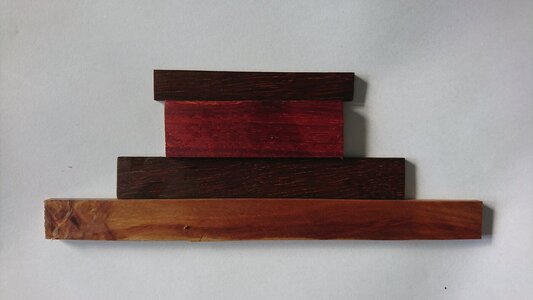
3.Padouk with clearcoat + ebony with linseed oil + pear with clearcoat
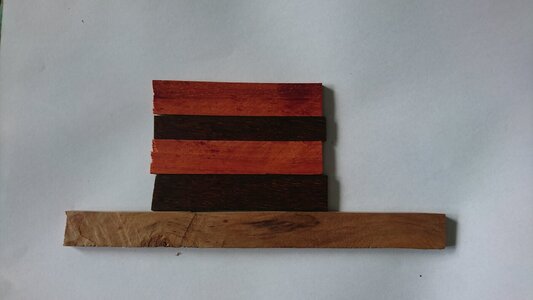
4.Padouk with clearcoat+pear stained to black + pear with linseed oil
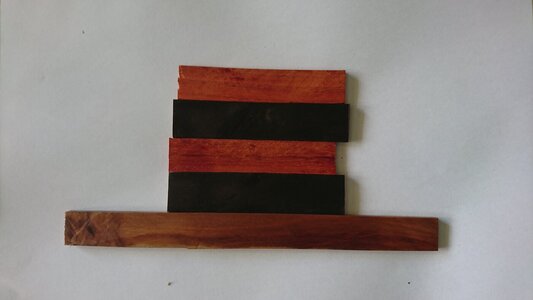
I have my likely favorite but i want to hear your opinions.
The problem
As you've already guessed african exotics are very hard to bend and I wasn't able to do it without braking planks
Solutions
1. Multiple veneer layers. 0,6mm
That would be a little cheeting, but for the exotics looks I wouldn't mind to do it
2.Making all planks in pear and staining it till I find satisfying colour
3."Classic" - Pear stained to black + pear with clearcoat/multiple veneer layers of peer 2mm* -> much brigher than pear with clearcoat.Very similar to the video version
Soo. What do you think about it?
*Of course I would adjust thickness to the plans
I've prapared some concepts about colors of planks. It all fell apart because of stiffnes of exotics. First I'll show them and later ask about your opinion to some solutions
Matching with plans(loosly)

From top
1.Pear stained to black+padouk with linseed oil + pear with linseed oil

2.Ebony with linseed oil +padouk with linseed oil + pear with linseed oil

3.Padouk with clearcoat + ebony with linseed oil + pear with clearcoat

4.Padouk with clearcoat+pear stained to black + pear with linseed oil

I have my likely favorite but i want to hear your opinions.
The problem
As you've already guessed african exotics are very hard to bend and I wasn't able to do it without braking planks
Solutions
1. Multiple veneer layers. 0,6mm
That would be a little cheeting, but for the exotics looks I wouldn't mind to do it
2.Making all planks in pear and staining it till I find satisfying colour
3."Classic" - Pear stained to black + pear with clearcoat/multiple veneer layers of peer 2mm* -> much brigher than pear with clearcoat.Very similar to the video version
Soo. What do you think about it?
*Of course I would adjust thickness to the plans
Use the brown one. 
Seriously though, the color you choose is a personal matter. If you want realism, the entire ship would be variations of darkness of the sample you made from pear with linseed oil, for timbers which were not painted of course. If you are looking to show off lines and features on the model, going with colors not found on real ships, like the oranges of padauk or the pinkish tan of raw pearwood, would work. It all depends on the purpose of the model, and art piece, or a photorealistic miniature ship. (Of course, making an accurate representation of a ship no one has laid eyes on in centuries is a problem, and artists' works handed down to us are often suspect with regard to accuracy.) Many builders blend the two and get something in between, but for me that spoils the illusion that you are looking at a real ship. I have yet to see orange woods used on old square riggers. Pleasure yachts maybe, but not sailing warships. Of course, there may be one or more exceptions out there. To brighten up the dull, dark browns of real ships, the surfaces were painted or covered with painted carvings and decorations. In modelling, the "painting with wood" is often used to show off the craftsmanship of the modeler and not attempt to show the real appearance of the ship. There are so many schools of style in model ship building. The safe answer is "build what you love".
Seriously though, the color you choose is a personal matter. If you want realism, the entire ship would be variations of darkness of the sample you made from pear with linseed oil, for timbers which were not painted of course. If you are looking to show off lines and features on the model, going with colors not found on real ships, like the oranges of padauk or the pinkish tan of raw pearwood, would work. It all depends on the purpose of the model, and art piece, or a photorealistic miniature ship. (Of course, making an accurate representation of a ship no one has laid eyes on in centuries is a problem, and artists' works handed down to us are often suspect with regard to accuracy.) Many builders blend the two and get something in between, but for me that spoils the illusion that you are looking at a real ship. I have yet to see orange woods used on old square riggers. Pleasure yachts maybe, but not sailing warships. Of course, there may be one or more exceptions out there. To brighten up the dull, dark browns of real ships, the surfaces were painted or covered with painted carvings and decorations. In modelling, the "painting with wood" is often used to show off the craftsmanship of the modeler and not attempt to show the real appearance of the ship. There are so many schools of style in model ship building. The safe answer is "build what you love".
Last edited:
I second what Kurt is saying about color. With regard to wood species, my personal preference would be to stear clear of open-grained woods like padouk, unless you are building in the really large scales like 1:36 or 1:48. Even at 1:72, which is still a relatively large model of this subject, the open grain is a distraction to my eyes.
Whether you stain it, or allow it to oxidize naturally, one can not go wrong with pear for model ship-building.
I like your methodical, probing approach to the planning stage of this build. You are quite right to make up samples and consider your options carefully.
Whether you stain it, or allow it to oxidize naturally, one can not go wrong with pear for model ship-building.
I like your methodical, probing approach to the planning stage of this build. You are quite right to make up samples and consider your options carefully.
I vote for number 4. It is a nice set of colors and good harmony, IMHO.
- Joined
- Jan 21, 2022
- Messages
- 853
- Points
- 403

@DARIVS ARCHITECTVS
Yes. Of course it's artistic approach. I was more curious about replacement of thick planks with veneer. Is it option to consider if I won't be able to bend them?
@Hubac’s Historian
Padouk was selected only for it's color. I view it's open-grain a sacrifice for a artistic looks
@Jimsky
The pictures are little misrepresent in comparision to real life, but nr.4 it's very close to
Sadly I don't know what wood and oils used Mr Shevelev beacuse google translator produces a lot of nonsence
For now option nr 2 and 4 is the first choice if I menage to bend exotics and "classic" option if I won't
Yes. Of course it's artistic approach. I was more curious about replacement of thick planks with veneer. Is it option to consider if I won't be able to bend them?
@Hubac’s Historian
Padouk was selected only for it's color. I view it's open-grain a sacrifice for a artistic looks
@Jimsky
The pictures are little misrepresent in comparision to real life, but nr.4 it's very close to
74 - пушечник-2 по чертежам Анкре 1:72 - Страница 23 - форум моделистов Судомоделизм
Ну да, логично конечно. Только модель предполагалось возить по выставкам, что я и делал с 2013 года, а без крышек как то не очень.
www.shipmodeling.ru
Sadly I don't know what wood and oils used Mr Shevelev beacuse google translator produces a lot of nonsence
For now option nr 2 and 4 is the first choice if I menage to bend exotics and "classic" option if I won't
Last edited:
Now I understand the look you're going for. Veneers are a really good option if you can't bend the wood, as long as you can't see the edges of the veneer, which may indicate to the viewer how thin it is. You don't want it to look like a veneer.@DARIVS ARCHITECTVS
Yes. Of course it's artistic approach. I was more curious about replacement of thick planks with veneer. Is it option to consider if I won't be able to bend them?
@Hubac’s Historian
Padouk was selected only for it's color. I view it's open-grain a sacrifice for a artistic looks
@Jimsky
The pictures are little misrepresent in comparision to real life, but nr.4 it's very close to
74 - пушечник-2 по чертежам Анкре 1:72 - Страница 23 - форум моделистов Судомоделизм
Ну да, логично конечно. Только модель предполагалось возить по выставкам, что я и делал с 2013 года, а без крышек как то не очень.www.shipmodeling.ru
Sadly I don't know what wood and oils used Mr Shevelev beacuse google translator produces a lot of nonsence
About Shevelev I can say that he uses a pear and a black hornbeam. Oil uses mainly Danish oil@DARIVS ARCHITECTVS
Yes. Of course it's artistic approach. I was more curious about replacement of thick planks with veneer. Is it option to consider if I won't be able to bend them?
@Hubac’s Historian
Padouk was selected only for it's color. I view it's open-grain a sacrifice for a artistic looks
@Jimsky
The pictures are little misrepresent in comparision to real life, but nr.4 it's very close to
74 - пушечник-2 по чертежам Анкре 1:72 - Страница 23 - форум моделистов Судомоделизм
Ну да, логично конечно. Только модель предполагалось возить по выставкам, что я и делал с 2013 года, а без крышек как то не очень.www.shipmodeling.ru
Sadly I don't know what wood and oils used Mr Shevelev beacuse google translator produces a lot of nonsence
For now option nr 2 and 4 is the first choice if I menage to bend exotics and "classic" option if I won't
- Joined
- Jan 21, 2022
- Messages
- 853
- Points
- 403

Thanks for the informationAbout Shevelev I can say that he uses a pear and a black hornbeam. Oil uses mainly Danish oil
- Joined
- Jan 21, 2022
- Messages
- 853
- Points
- 403

Hello.
Today is more like information post than update. There proved to be a problem with resign hull. Little mistake in printng. It's a few dozen mm to short and it shifted some key points. @SZKUTNIK is already printing a new one. Since I don't have to stick so stricly to plans I've decided to finish it as L'Ocean.
"This model, although bearing the name L'Océan on the back, does not strictly speaking represent any ship that belonged to the French Navy. It is a demonstration model, similar to those in use in naval schools, where you can see in all detail the rigging of a large ship..." Thus I don't have any problems with historical coretness.
 mnm.webmuseo.com
mnm.webmuseo.com
After advice of @Hubac’s Historian also decited to make it all in pear with staining to diffrent colors
First plank.
I made grooves with 0,7mm milling cutter and this indentations for windows with this
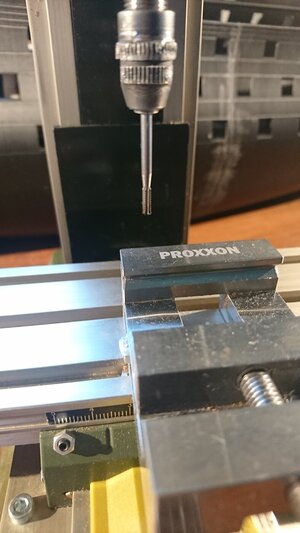
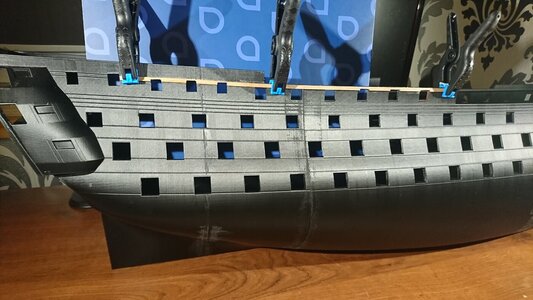
After staining to black.
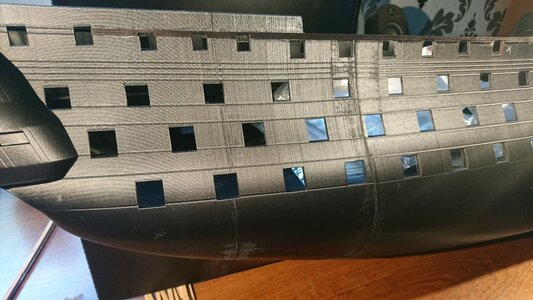
Today is more like information post than update. There proved to be a problem with resign hull. Little mistake in printng. It's a few dozen mm to short and it shifted some key points. @SZKUTNIK is already printing a new one. Since I don't have to stick so stricly to plans I've decided to finish it as L'Ocean.
"This model, although bearing the name L'Océan on the back, does not strictly speaking represent any ship that belonged to the French Navy. It is a demonstration model, similar to those in use in naval schools, where you can see in all detail the rigging of a large ship..." Thus I don't have any problems with historical coretness.
Oeuvre : Précisions - Maquette de bateau, Océan, vaisseau de 1er rang, fin 18e siècle | Les collections du musée | Musée national de la Marine
Notice d'oeuvre ''Maquette de bateau, Océan, vaisseau de 1er rang, fin 18e siècle'' du musée ''Les collections du musée | Musée national de la Marine''
After advice of @Hubac’s Historian also decited to make it all in pear with staining to diffrent colors
First plank.
I made grooves with 0,7mm milling cutter and this indentations for windows with this


After staining to black.

I am looking forward to see how to work on such a pre-fabricated hull form - many thanks for showing us your experiences
- Joined
- Jan 21, 2022
- Messages
- 853
- Points
- 403

@SZKUTNIK
Czyli najpierw zrobić uszczelnienia otworów działowych.Dobrze zrozumiałem?
Should I first make sealings of gun ports.Have I understood that correctly??
Ten polecany klej Patexx Uniwersal zostawia ciągnące się glutki. Da się je potem w większości zeskrobać,ale nie do końca.Obawiam się, że przy większej ilości listewek część na pewno się pobrudzi. Testowaliście może inne kleje? Może jakiś cyjanoakryl w żelu.
The recommended glue Patexx Uniwersal leaves a sticky residue.They can then be mostly scraped off, but not completely. I am afraid that with more strips some of them will get dirty. Have you tried any other glues? Maybe some cyanoacrylates in gel.
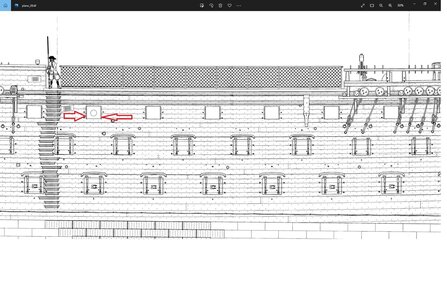
I used a veener as a first version of plank. It was to fragile I broke couple of strips and chaned it to 2mm pear form real wood
Czyli najpierw zrobić uszczelnienia otworów działowych.Dobrze zrozumiałem?
Should I first make sealings of gun ports.Have I understood that correctly??
Ten polecany klej Patexx Uniwersal zostawia ciągnące się glutki. Da się je potem w większości zeskrobać,ale nie do końca.Obawiam się, że przy większej ilości listewek część na pewno się pobrudzi. Testowaliście może inne kleje? Może jakiś cyjanoakryl w żelu.
The recommended glue Patexx Uniwersal leaves a sticky residue.They can then be mostly scraped off, but not completely. I am afraid that with more strips some of them will get dirty. Have you tried any other glues? Maybe some cyanoacrylates in gel.

I used a veener as a first version of plank. It was to fragile I broke couple of strips and chaned it to 2mm pear form real wood
Last edited:
- Joined
- Apr 10, 2020
- Messages
- 372
- Points
- 323

Ahoy!
@WojtasS - Yes - make sealings of gun ports first.
Glue - cyanoacrylates in gel is also OK. Pattex also is OK. Maybe you used too much glue in one place?
Veener.... the quality of the material is very important. We using veener from real wood ONLY. If necessary, we can laser cut the veneer into strips of the appropriate width at the modeller's request,.
@WojtasS - Yes - make sealings of gun ports first.
Glue - cyanoacrylates in gel is also OK. Pattex also is OK. Maybe you used too much glue in one place?
Veener.... the quality of the material is very important. We using veener from real wood ONLY. If necessary, we can laser cut the veneer into strips of the appropriate width at the modeller's request,.
I think that the complete gunport lining should be prepared, so sills, lintel and also stops
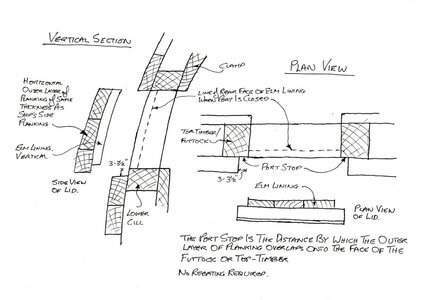
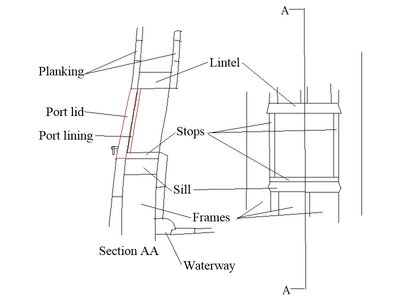
with this installed you can install the "planking" overlapped and the plastic base will be completely covered.
An additional advantage: you can use a small drop of wood glue at the end where wood contact wood


with this installed you can install the "planking" overlapped and the plastic base will be completely covered.
An additional advantage: you can use a small drop of wood glue at the end where wood contact wood
- Joined
- Apr 10, 2020
- Messages
- 372
- Points
- 323

Ahoy!
 The contractor knows how much time he saved while building the model.
The contractor knows how much time he saved while building the model. 
@Uwek - You have the absolute reason. We must completely cover the plastic with wood. Such is the principal idea of sticking of 3D Print hull. The viewer is to see a WOODEN MODEL of the sailing ship.I think that the complete gunport lining should be prepared, so sills, lintel and also stops
View attachment 315863 View attachment 315864
with this installed you can install the "planking" overlapped and the plastic base will be completely covered.
An additional advantage: you can use a small drop of wood glue at the end where wood contact wood
Last edited:


